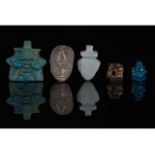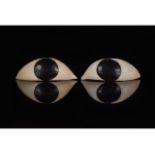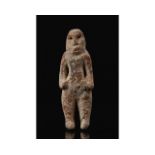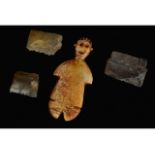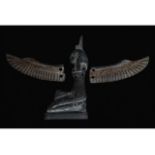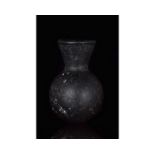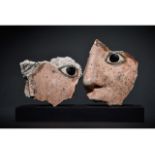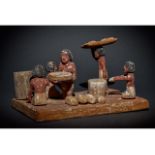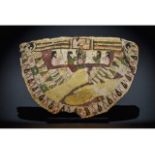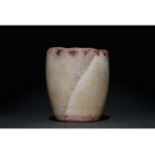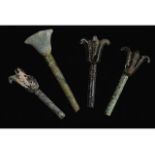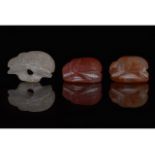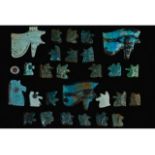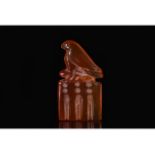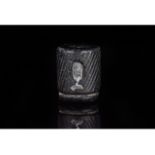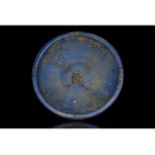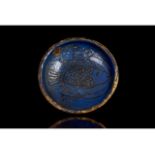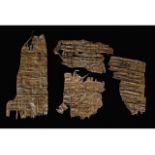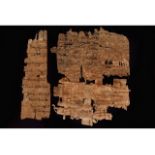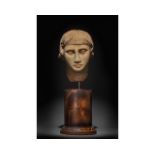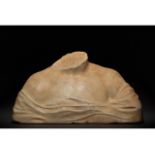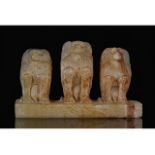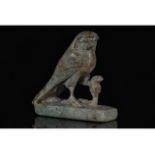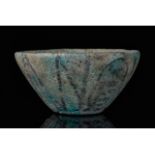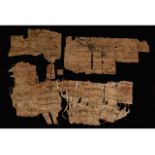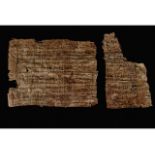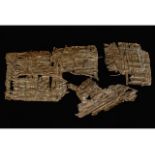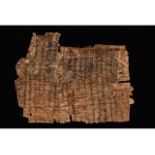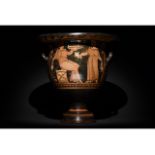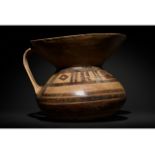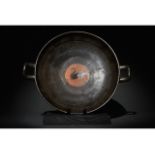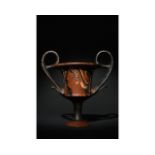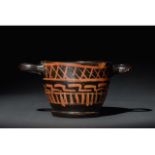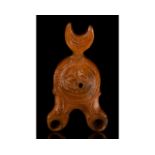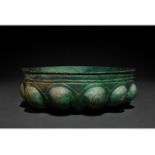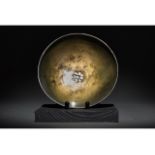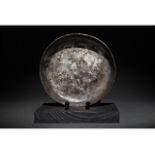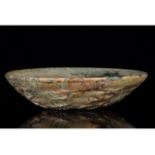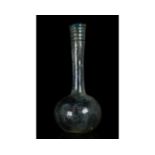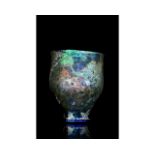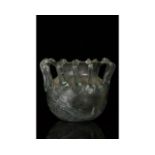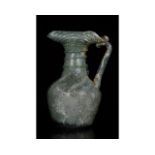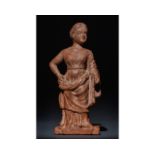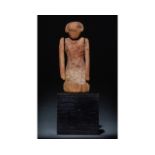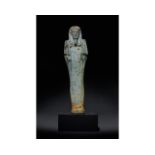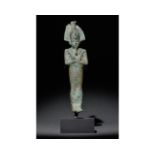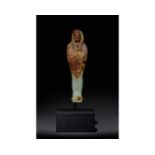Refine your search
Estimate
Category
- Arms, Armour & Militaria (102)
- Jewellery (80)
- Greek, Roman, Egyptian & Other Antiquities (54)
- Sculpture (35)
- Chinese Works of Art (25)
- Collectables (19)
- Glassware (15)
- Books & Periodicals (14)
- Scientific Instruments (14)
- Ceramics (11)
- Models, Toys, Dolls & Games (7)
- Taxidermy & Natural History (6)
- Coins (4)
- Vintage Fashion (4)
- Stamps (3)
- Metalware (2)
- Textiles (2)
- Bank notes (1)
- Furniture (1)
- Kitchenalia (1)
- Oil, Acrylic paintings & Mixed Media (1)
- Russian Works of Art (1)
- Salvage & Architectural Antiques (1)
- Silver & Silver-plated items (1)
Filtered by:
- Item Type
- List
- Grid
A subscription to the Price Guide is required to view results for auctions ten days or older. Click here for more information
Ca. 323 BC-200 AD. Ptolemaic Dynasty - Roman Period. A group of 54 small objects including glass inlays, beads, and a seashell. Inlays were common...
Ca. 664-30 BC. Late Period - Ptolemaic Dynasty. A group of four amulets and a statuette head. These include a blue-glazed faience head of the god ...
EGYPTIAN PAIR OF EYE INLAYS
Ca. 1069-332 BC. Third Intermediate Period - Late Period. A pair of coloured glass eyes intended as inlays within a mummy mask. The eyes have scle...
EGYPTIAN FEMALE FIGURINE
Ca. 3500-2200 BC. Predynastic Period - Old Kingdom. An anthropomorphic statuette of a human figure. It is highly schematised, with no clear detail...
Ca. 4000-3000 BC. Predynastic Period. A group of prehistoric stone tools and a statuette. The three tools are knapped flint and are each roughly r...
EGYPTIAN INLAY OF ISIS
Ca. 664-30 BC. Late Period - Ptolemaic Dynasty or later. A black inlay of the goddess Isis. She is depicted in profile, kneeling on a plinth with ...
EGYPTIAN BLACK VESSEL
Ca. 3500-3000 BC. Predynastic Period. A black stone vessel. It features a flat surface, above which is a spherical, bulbous body, and a conical ne...
EGYPTIAN BENNU BIRD STATUETTE
Ca. 323 BC-200 AD. Ptolemaic Dynasty - Roman Period. A statuette of a Bennu bird. It is a pale buff colour with reddish-brown patches, which sugge...
Ca. 323 BC-395 AD. Graeco-Roman Period. Ceramic fragments of a face. These come from a sculptural head in the Classical style. They are decorated ...
Ca. 400-900 AD. Late Antique Period. A pair of carved wooden plaques. Both are unpainted, and each has a central area in raised relief so that the...
Ca. 2055-1650 BC. Middle Kingdom. A wooden tomb model of a bakery. This model features five men, painted with red ochre skin, black hair and facia...
Ca. 323 BC-300 AD. Graeco-Roman Period. A wesekh ('broad') collar made of cartonnage, a plastered material, to be worn by a mummy. The collar is s...
EGYPTIAN ALABASTER CUP
Ca. 2055-1077 BC. Middle Kingdom - New Kingdom. A small cup of Egyptian alabaster. It has a flat base and a round body which rises almost straight...
Ca. 664-30 BC. Late Period - Ptolemaic Dynasty. A group of four glaze faience sceptres and rods. Each has a long cylindrical rod topped with a dif...
EGYPTIAN TRIO OF STONE SCARABS
Ca. 664-332 BC. Late Period. A trio of stone scarabs. Two are red carnelian and one is a white stone. The red scarabs have rounded beetle-like upp...
EGYPTIAN 28 EYE AMULETS
Ca. 664-30 BC. Third Intermediate Period to Late Period. A group of 28 amulets depicting eyes, mostly in the typical fashion of the Eye of Horus. ...
EGYPTIAN ELEVEN AMULETS
Ca. 664-30 BC. Late Period - Ptolemaic Dynasty. A group of eleven small statuettes of varying sizes. The largest shows a crouching baboon with a s...
EGYPTIAN SEREKH AMULET
Ca. 1550-1077 BC. New Kingdom. A carnelian amulet in the shape of a serekh. A perched falcon of Horus sits on top of a schematic façade of a palac...
EGYPTIAN BLACK CARTOUCHE BEAD
Ca. 1550-1077 BC. New Kingdom. A black-glazed faience bead. The bead is cylindrical, with a suspension hole running through it. The exterior is de...
Ca. 664-332 BC. Late Period. A pale blue-glazed faience shabti. The head wears a lappet wig and a false beard, with detailed facial features model...
EGYPTIAN LOTUS BOWL
Ca. 2055-1650 BC. Middle Kingdom or later. A blue-painted ceramic bowl. It is made of Nile silt clay and painted with Egyptian blue on most of the...
EGYPTIAN TILAPIA FISH BOWL
Ca. 2055-1650 BC. Middle Kingdom or later. A dark blue-glazed faience bowl depicting a tilapia fish. It has a wide flat base, and its edges flair ...
Ca. 323 BC-400 AD. Graeco-Roman Period. A mummy mask and a mummy's torso piece. Both are made of cartonnage, a plaster-like substance that incorpo...
EGYPTIAN PAPYRUS WITH GREEK TEXT
Ca. 323 BC-641 AD. Graeco-Roman Period. Four fragments of papyrus inscribed with Greek text in black ink. Papyrus was a practical precursor to pap...
EGYPTIAN PAPYRUS WITH DEMOTIC TEXT
Ca. 323 BC-500 AD. Graeco-Roman Period. Fragments of papyrus inscribed with Demotic text in black ink. Demotic was the fourth phase of the Egyptia...
EGYPTIAN MARBLE HEAD OF A WOMAN
Ca. 323 BC-395 AD. Graeco-Roman Period or later. A marble head of a woman on a modern stand. This elegant piece principally uses the Classical sty...
Ca. 1700-1800 AD. A neoclassical marble bust of a woman in roman style, missing its head. It is rendered in a life-like Classical style, with a to...
EGYPTIAN FAIENCE SHABTI
Ca. 332-30 BC. Ptolemaic Dynasty. A deep blue-glazed faience shabti. The head wears a lappet wig and a false beard, with detailed facial features ...
Ca. 1550-1077 BC. New Kingdom. A sculpture of three baboons. The trio sits upon a long and thick plinth. Each baboon is shown seated, and the midd...
Ca. 323 BC-200 AD. Graeco-Roman Period. A green stone statuette of a falcon catching a snake. The falcon stands on a long and thick plinth with it...
Ca. 664-332 BC. Late Period. A pale blue-glazed faience shabti. The head wears a lappet wig and a false beard, with detailed facial features model...
EGYPTIAN CAT AMULET
Ca. 664-30 BC. Late Period - Ptolemaic Dynasty. A stone amulet of a cat. The cat is seated on a rectangular plinth, with its rear legs crouching a...
Ca. 1550-1077 BC. New Kingdom. A blue-glazed faience bowl. It has a flat base and edges that flair outwards to a simple rim. It is glazed inside a...
EGYPTIAN PAPYRUS FRAGMENTS
Ca. 323 BC-641 AD. Graeco-Roman Period. Fragments of papyrus inscribed with Greek text in black ink. Papyrus was a practical precursor to paper, p...
Ca. 323 BC-500 AD. Graeco-Roman Period. A sheet and a fragment of papyrus inscribed with Demotic text in black ink. Demotic was the fourth phase o...
Ca. 323 BC-500 AD. Graeco-Roman Period. Fragments of papyrus inscribed with traces of Demotic text in black ink. Demotic was the fourth phase of t...
Ca. 323 BC-500 AD. Graeco-Roman Period. A sheet of of papyrus inscribed with Demotic text in black ink. Demotic was the fourth phase of the Egypti...
Ca. 400-300 BC. Apulian. This beautiful red-figure bell terracotta krater with everted rim features a pedestal foot, a cylindrical stem, a bell-sh...
Ca. 400-300 BC. Daunian. A large pottery krater with a globular body, funnel-shaped neck, and a strap handle. The body is decorated with a series ...
Ca. 520-450 BC. Greek Attic. A beautiful black-figure Attic kylix, i.e. a wide-bowled drinking cup with a large, black glazed low foot and twin ho...
Ca. 350-300 BC. Apulian. A rare red-figure kantharos. This tall stemmed cup has two sweeping high handles and a gently flared body that sits on a ...
GREEK APULIAN XENON WARE SKYPHOS
Ca. 400-300 BC. Apulian. An ancient Apulian xenon-ware skyphos, i.e. a deep wine cup with a low flanged base and dual-handle below a slightly thic...
Ca. 400-500 AD. Late Roman. A large terracotta, twin flame oil lamp with two voluted round-tipped nozzles and a crescent moon-shaped handle with a...
Ca. 400-500 AD. Late Roman. A wonderfully preserved, mould-made terracotta lamp in the style created in Roman North Africa. It has a rich, deep re...
Ca. 100-300 AD. A beautiful terracotta oil lamp featuring a large, rounded concave body, a round nozzle, and a filling hole slightly off the centr...
Ca. 100-300 AD. A beautiful terracotta oil lamp featuring a large, rounded concave body, a round nozzle, a circular handle, and a filling hole at ...
Ca. 400-500 AD. Late Roman. A wonderfully preserved, mould-made terracotta lamp in the style created in Roman North Africa featuring a large, roun...
Ca. 500-330 BC. Central Asian/ Mediterranean. A beautiful hammered bronze phiale (libation dish). The exterior surface is decorated with eleven eg...
Ca. 500-330 BC. Graeco/Achaemenid. A bronze libation bowl known as 'phiale' decorated with a central rosette. Phialai were wide shallow cups used ...
Ca. 100-300 AD. Roman. A beautifully preserved, hammered silver vessel with a plain rim and an interior surface decorated with an incised ring of ...
Ca. 100-300 AD. Roman. A rare, yellow-green coloured glass dish with a folded broad rim. The interior surface is plain whilst the outside is decor...
Ca. 100-300 AD. Roman. A beautiful colourless with green tinge glass flask with a spherical body, a long, flaring cylindrical neck, and a wide mou...
Ca. 100-300 AD. Roman. A superb glass beaker with a slightly everted rounded rim, an incised spiral decoration below, a deep blue-coloured ring fo...
Ca. 400-500. Late Roman. A fine glass jar with an apple-shaped body and an everted rim. The most striking feature of this item is the twelve handl...
Ca. 300-400 AD. Late Roman. A dark-coloured glass jug with a near-spherical body, a cylindrical neck decorated with a spiral trail, a splayed lip ...
Ca. 200 AD. Middle-Imperial Roman. A beautifully preserved female terracotta figure standing with her weight on her right leg, her left bent forwa...
Ca. 2055 -1650 BC. Middle Kingdom. An articulated wooden tomb figure. The statuette's surface contains traces of white at the waist where a kilt w...
Ca. 664-332 BC. Late Period. A pale blue-glazed faience shabti on a modern stand. The head wears a striated lappet wig and a false beard, with exq...
Ca. 664-30 BC. Late Period - Ptolemaic Dynasty. A bronze statuette of Osiris on a modern stand. He wears an atef crown, plumed on each side with o...
Ca. 664-332 BC. Late Period. A pale blue-glazed faience shabti on a modern stand, with a reddish-brown colouring over the upper half of the front....



